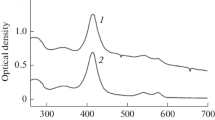Abstract
WHEN deoxyribonucleic acid is subjected to the Feulgen reaction, the pigment which develops may be soluble in water or dilute acid, as the Stedmans1 have suggested. If deoxyribonucleohistone extracted from nuclei of beef spleen by the method of Mirsky and Pollister2 is treated in the same manner, the colour develops almost exclusively on the precipitate.
Similar content being viewed by others
References
Stedman, E., and Stedman, E., Nature, 152, 267 (1943).
Mirsky, A. E., and Pollister, A. W., J. Gen. Physiol., 30, 117 (1946).
Petermann, M. L., and Lamb, M., J. Biol. Chem., 176, 685 (1948).
Choudhuri, H. C., Nature, 152, 475 (1943).
Danielli, J. F., Symp. Soc. Exp. Biol., 1, 101 (1947).
Author information
Authors and Affiliations
Rights and permissions
About this article
Cite this article
SIBATANI, A. Effects of Histone and other Proteins on the Feulgen Reaction. Nature 166, 355–356 (1950). https://doi.org/10.1038/166355a0
Issue Date:
DOI: https://doi.org/10.1038/166355a0
- Springer Nature Limited
This article is cited by
-
DNA-Feulgen value in brain cells of the adult worker honeybee dependent on age
Experientia (1974)
-
Quantitative DNS-Bestimmungen von Ameisenhirnzellen
Histochemie (1970)
-
Quantitative DNS-Bestimmungen von Ameisenhirnzellen
Chromosoma (1970)
-
Some aspects of the Feulgen reaction in situ
Histochemie (1969)
-
Zytophotometrische Bestimmungen des DNS-Gehaltes von Zellkernen des Nebennierenmarkes, der Nebennierenrinde und der Schilddr�se unter verschiedenen experimentellen Bedingungen
Histochemie (1967)




